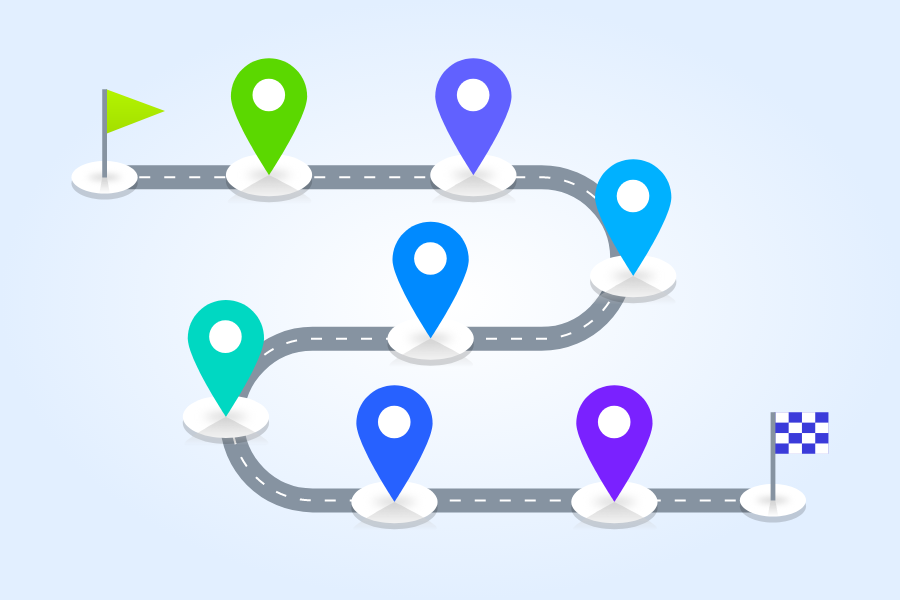
When working on a project, it’s important to measure and track its progress. The best way to do this in project management is by setting up milestones which is a significant progress point that appears on a project timeline.
What is a milestone in project management?
Milestones in project management are points in a project that measure its progress. They act as checkpoints on your project line and help segregate project phases. In a project, milestones mark important events like start dates, end dates, review, signoffs, budget checkpoints of critical deliverables, and much more.
Why do you need milestones in project management?
Milestones are essential for many reasons. They help to track parameters and are viewed as the steppingstones to a project’s success. If you know you can't meet a milestone on schedule, then you know that the whole project could get delayed which could have an impact on costs and resources. Milestones help you gain overall visibility across the project and help you make timely decisions.
The benefits of milestones
Project milestones provide many benefits not only to the project managers, but also to the stakeholders and all the project team members. Some of the main benefits that you can gain from using milestones include:
Track important dates
Milestones help project stakeholders monitor due dates and critical deadlines of a project. The dates may be related to work dependent on an internal team or an external partner and can help track dependencies.
Gain project visibility
The project visibility increases as you’re able to spot critical dates and deliverables in a project.
Read on: Gain insight with ERP project management dashboards
Resource allocation
Using milestones helps project managers effectively distribute a project's resources so that the projects get delivered on schedule and within the budget.
Vendor payments
Payment is made to vendors once the milestones are successfully completed. Milestones also enable prompt tracking.
Improves accountability
Project plans have milestones associated with various parties, and milestones help stakeholders track deliverables.
Keep teams motivated
They can help teams stay motivated in completing their tasks so that they can move on to newer milestones.
Examples of project milestones
So that you get a better understanding of milestones, here are some examples of project milestones that are typically used in a project:
- The start and end dates for deliverables in project phases
- Getting approval from a stakeholder that allows you to move to the next phase
- Key deliverables, meetings, or events
- Budget checks
- External or internal reviews, approval, payments
- Tests or inspections on deliverables or delivered sample goods
What is a milestone schedule?
A milestone schedule is a timeline that divides a project schedule into critical phases using milestones. One can share an overview of the project schedule with important milestones without getting into details.
How to set milestones and phases of project management
As per the Project Management Institute (PMI), there are typically five phases in project management. These phases are:
- Initiation
- Planning
- Execution
- Monitoring & controlling
- Closure
You can add a milestone in any phase of your project. For example, you can have an ‘Initiation’ phase milestone for the budget approval.
When setting project milestones, it’s important to first decide what point in a project can be considered a milestone.
However, milestones can vary according to your project. You can create milestones that show key tasks, significant events, deliverables, and more.
Read on: Phases and core components of project management
How to use milestones in Gantt charts
When you use any project management software like Vault, you can create milestones while adding tasks to your schedule. Once you’ve chosen the task name, start date, due date, and dependencies, you have to check a box to mark any task as a milestone. The milestone then appears in your project timeline and Gantt chart.
Vault enables you to take maximum advantage of milestones in your project management and simplifies the Gantt chart which gives you a clear project overview.
How to visualize project milestones
During project planning, when you create a schedule chart to add details on tasks like duration, start and due dates, dependencies, etc., the Gantt chart populates the project timeline automatically in real-time.
You can easily create a project timeline and view how your project maps out over time with important milestones.
How to share milestones with stakeholders
You can easily share milestones with stakeholders by converting the project timeline and milestones into a real-time dashboard with Vault.
Milestones are essential features of project management tools. Vault, our cloud-based project management software, offers rich features that allow your teams to become more productive.
Project management has various phases, and you can get more control over projects by defining milestones across various project phases. Keep track of important project aspects and measure success as you progress with quick and easy set-up of milestones.
Discover Vault. Sign up for a free demo today.
.png)